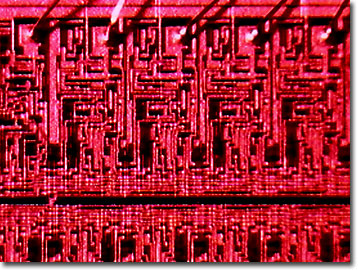Integrated Circuit Image Gallery
Read-Only Memory (ROM) Integrated Circuit
The original read-only memory (or ROM) integrated circuits were a type of memory that was programmed once and could not be overwritten or changed. In the factory, programmable read-only memory (PROM) chips provide the manufacturers the opportunity to store software in a region of a personal computer or other electronic device that cannot be erased, thus the name "firmware" and the classification as nonvolatile memory.

When the power is removed from a hand-held device or desktop computer, the ROM circuitry does not lose its contents as it would if it were a random-access memory (RAM circuit. Originally produced in 1969 by Intel for an innovative four-chip calculator designed by the Japanese firm Shima, the read-only memory integrated circuit stored the program instructions. The basic input/output system (BIOS) that instructed the earliest personal computers how to initialize and boot was stored on primitive ROM devices. While RAM uses transistors to turn on or off access to a capacitor at each intersection of a grid containing columns and rows, the binary ROM chips utilize diodes to connect or disconnect signal wires.
Many types of ROM chips exist today, including electrically erasable and reprogrammable memory. Electronically erasable programmable read-only memory (EEPROM) and Flash ROM chips have increased the versatility of existing hardware and extended the life of some components by offering upgrades via memory reprogramming. Fixing hardware and software glitches and bugs can be performed in the home or office instead of having to return equipment to the factory. Originally ROM chips were fabricated in units of 512 bytes, with early Apple Macintosh machines equipped with a total of 128 kilobytes, and the original IBM computers loaded with ROM chips that contained 256 instructions of 10 bits each. The 4-kilobyte ROM chip was developed at Hewlett-Packard to support their programmable calculators using N-channel metal oxide semiconductor (NMOS) fabrication techniques. Today, a battery-powered pocket computer may feature 32 megabytes of ROM while a full-blown network server may harness dozens of 256-megabyte Flash memory components, plus many gigabytes of synchronous dynamic RAM.
Contributing Authors
Omar Alvarado, Thomas J. Fellers and Michael W. Davidson - National High Magnetic Field Laboratory, 1800 East Paul Dirac Dr., The Florida State University, Tallahassee, Florida, 32310.
BACK TO THE INTEGRATED CIRCUIT IMAGE GALLERY
BACK TO THE DIGITAL IMAGE GALLERIES
Questions or comments? Send us an email.
© 1995-2025 by Michael W. Davidson and The Florida State University. All Rights Reserved. No images, graphics, software, scripts, or applets may be reproduced or used in any manner without permission from the copyright holders. Use of this website means you agree to all of the Legal Terms and Conditions set forth by the owners.
This website is maintained by our
Graphics & Web Programming Team
in collaboration with Optical Microscopy at the
National High Magnetic Field Laboratory.
Last Modification Friday, Nov 13, 2015 at 01:19 PM
Access Count Since September 17, 2002: 18084
Visit the website of our partner in introductory microscopy education:
|
|
